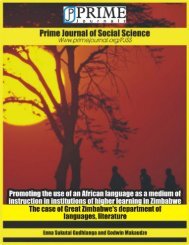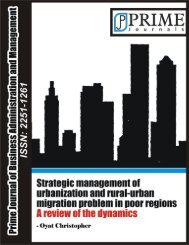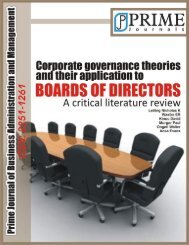See Full Article [pdf] - prime journals limited
See Full Article [pdf] - prime journals limited
See Full Article [pdf] - prime journals limited
Create successful ePaper yourself
Turn your PDF publications into a flip-book with our unique Google optimized e-Paper software.
303 Prime Research on Education(Course facilitation) as a support service?- How do NOUN students perceive information as a supportservice?- How do students perceive orientation as a supportservice at NOUN?- How do students perceive course registration as asupport service at NOUN?- How do students perceive matriculation as learners‟support service?- How do students perceive counseling as learnerssupport services at NOUN?- How do students perceive Assessment/Evaluation aslearning support service at NOUN?- How do students perceive course materials as learnerssupport service at NOUN?- How do students perceive multimedia as supportservice at NOUN?- How do students perceive support staff as learnerssupport service at NOUN?The research was carried out in 5 of the six regions ofNigeria. A study centre in each of the five regions wasselected and used for the study. The students in theselected centres constituted the subject of the research.The Study is very significant to the National Open Universityof Nigeria (NOUN) in particular, as it highlights thestudents‟ perception of Learners Support Services providedby the University that tend to bridge the gap betweenstudents and course lecturers (coordinators). It will helpthe University to plug loopholes in their support serviceswhich may work against academic progress and theprocess of teaching/learning transaction. In general, thestudy is significant to the Nigerian Education Systemespecially, as far as the Open and Distance EducationPolicy is concerned. It is also helpful to other ODL institutionswhich provide support services to students.Dillon et al., (1992), had examined learner supportsystems in a state-wide instructional televisionprogramme and noted that students listed the followingfactors as hindering their performance in the interactivetelevision courses:- Instructor‟s negative attitude toward off-campusstudents- of instructor contact outside class- Lack of feedback from instructor- Unavailability of library resources- Technical problems related to audio- Lack of training in the use of media for both instructorand students- Poor courier service, (distribution of course materials tosite)- Unruly behavior of students at remote sites.In a study, entitled Students‟ Perception of EffectiveDimension of Interactive Learning in a Blended LearningEnvironment, Delialioglu, Omer and Yildirim (2007),investigated Students‟ Perceptions of the effective dimensionsof interactive learning in a hybrid course. A casestudy design was used and 25 students enrolled incomputer networks and communication, a course at publicuniversity in Turkey, formed the sample of this studywhich lasted for 14 weeks. At the end of the study,interviews were conducted to gather data on effectivedimensions of interactive learning. Additionally, computerlogs of the students were kept and analyzed to triangulatethe interview data. The findings of the studyshowed that the way instructionists and constructivistelements are blended, the need for metacognitive support,authentic learning activities, collaborations, typesand source of motivation individualized learning andaccess to the internet played important roles in studentslearning in hybrid course.In a related study on the students‟ Affective Learningcognition and motivation Baker (2010), using the Instructionpresence scale. Instructor Immediacy Scale (Garham1988), Six-scale measure of Affective Learning (McCroskeyet al, 1985), Learning loss Scale (Richmond et al 1987),and Student Motivation Measure (Christophel, 1990),found out that instructor presence positively impactedstudents affective learning, cognition and motivation. Theimplication of this is that the study provides insights foronline instructors looking for specific indicators toimprove their students learning experiences. According toPicciano (2002), practitioners can establish presence intheir Online learning environment by engaging studentsthrough the methodical design, facilitation and direction ofcourse.As we enter into the information Technology era, thereis rapid advancement in information technology and easyaccess to the internet. Many institutions of higher learningare taking advantage of these phenomena by offeringcomputer-based learning, multimedia assisted learning ordistance learning courses to cater for the students‟needs. As a result, academicians are actively involved inthe development of web-based teaching materials.In a study entitled students‟ Perception of MultimediaComputer mediated learning, Wei, Hoon, Yussof, Naimand Suliman (2005) established that overall rating forMML for both Science and Arts students fall in the rangeof 40% to 50%. The average means score for MML contentand MML system for both streams of students isbelow 3. This means that students generally still prefer aconventional learning style which covers face to facelectures, textbooks and senior notes. They also concludedthat the major problems faced by students in MML isthe slow download time and server being always down.Academic guidance and counseling is emerging as acrucial aspect of students‟ support services especially fordistance education students. However, not all open anddistance learning institutions have organized studentsupport service in a systematic way. Some distancelearning institutions see guidance and counseling as anAmini 304


![See Full Article [pdf] - prime journals limited](https://img.yumpu.com/42270022/4/500x640/see-full-article-pdf-prime-journals-limited.jpg)


![See Full Article [pdf] - prime journals limited](https://img.yumpu.com/49292987/1/190x245/see-full-article-pdf-prime-journals-limited.jpg?quality=85)



![See Full Article [pdf] - Prime Journals](https://img.yumpu.com/44526114/1/190x245/see-full-article-pdf-prime-journals.jpg?quality=85)



![See Full Article [pdf] - Prime Journals](https://img.yumpu.com/41607332/1/190x245/see-full-article-pdf-prime-journals.jpg?quality=85)
![See Full Article [pdf] - Prime Journals](https://img.yumpu.com/41231982/1/190x245/see-full-article-pdf-prime-journals.jpg?quality=85)

